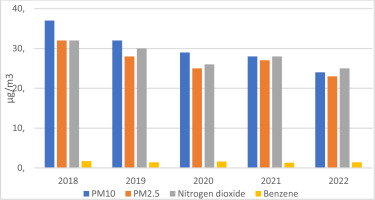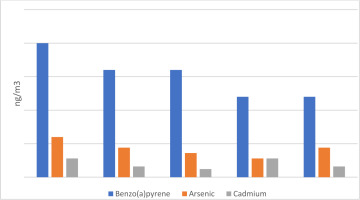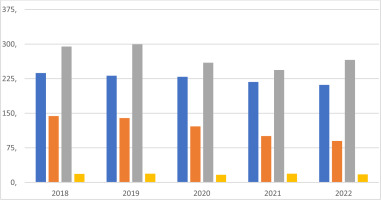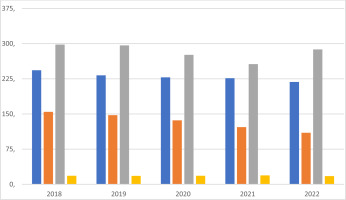Introduction
Based on the analysis of the European Commission, approximately 47,000 Polish residents die prematurely every year due to air pollution, including 36,500 due to PM2.5 suspended dust [1]. 9 out of 10 people in the world breathe polluted air, which causes approximately 7 million deaths annually [2].
The main source of air pollution in Bielsko-Biała and in the Silesian Voivodeship is anthropogenic emissions from the municipal and domestic sector (surface emissions), with a smaller share from industry (point emissions) and transport (linear emissions). Short-term exposure to high concentrations over a period of several hours to several days causes a severe reaction of the body of the most sensitive groups of the population, and the effects of this exposure include:
– adverse effect on lung function, especially in people belonging to groups sensitive to air pollution,
– intensification of symptoms of existing diseases, mainly of the circulatory and respiratory systems,
– premature deaths, especially related to respiratory and cardiovascular diseases,
– more doctor visits, involvement of the emergency services and hospitalizations due to respiratory and circulatory system diseases,
– increase in medication consumption,
– increase in the number of days absent from school and work [3].
Long-term exposure to air pollution, to even relatively low levels of pollution but lasting for many months or years, is associated with chronic diseases. These may include:
– respiratory diseases, including: asthma, chronic obstructive pulmonary disease, lung cancer,
– cardiovascular disease,
– mortality due to cardiovascular and respiratory diseases,
– chronic changes in the physiological functions of other organs secondary to disorders of the respiratory or circulatory system,
– gradual weakening of the immune system, especially in sensitive people, those treated for chronic diseases or diagnosed with diseases at an advanced stage [4-7].
Aim of the work
The objectives of the work were to assess the level of atmospheric air pollution in the city of Bielsko-Biała in the years 2018-2022 in terms of nitrogen dioxide, suspended particulate matter PM2.5 and PM10, benzene, benzo(a)pyrene and lead, cadmium and arsenic, and to present ways to prevent low emissions. The number of hospitalized residents of Poland and the Silesian Voivodeship was also taken into account in Silesia in the years 2018-2022 due to cancer (C00-D48), respiratory diseases (J00-J99), circulatory system diseases (I00-I99) and congenital defects and deformations (Q00-Q99).
Material and methods
The article takes into account data from the Provincial Inspectorate of Environmental Protection in Katowice (PIEP), Branch Office in Bielsko-Biała. The next step was to prepare appropriate charts showing the concentrations of selected elements and chemical compounds in the air in 2018-2022. Data from the Health Department of the Silesian Voivodeship Office in Katowice were also used regarding the number of hospitalized residents of Poland and the Silesian Voivodeship (coefficient 10,000) due to cancer, respiratory and circulatory system diseases, congenital defects and deformities.
Results
Pursuant to Art. 89 of the Act of April 27, 2001, Environmental Protection Law (Journal of Laws of 2021, item 1973, as amended), the Chief Inspector of Environmental Protection assesses the levels of substances in the air in a given zone for the previous year, and then classifies zones for each substance separately, according to specific criteria. Air quality assessment is carried out according to the criteria set out in Directive 2008/50/ EC of the European Parliament and of the Council of 21 May 2008 on air quality and cleaner air for Europe and Directive 2004/107/EC of the European Parliament and of the Council of 15 December 2004 on arsenic, cadmium, nickel, mercury and polycyclic aromatic hydrocarbons in ambient air. Currently, 12 substances are subject to health protection assessment: sulfur dioxide (SO2), nitrogen dioxide (NO2), carbon monoxide (CO), benzene (C6H6), ozone (O3), PM10 fine dust (up to 10µm in diameter), fine dust PM2.5 (with a diameter of up to 2.5 µm), heavy metals: lead (Pb), arsenic (As), nickel (Ni), cadmium (Cd) determined in PM10 dust and benzo(a) pyrene determined in PM10 dust. For plant protection purposes, three substances are subject to assessment: sulfur dioxide (SO2), nitrogen oxides (NOx) and ozone (O3). For each of the above-mentioned pollutants, there are specific concentrations in the air that should not be exceeded [8].
Permissible levels are specified for sulfur dioxide (SO2), nitrogen dioxide (NO2), carbon monoxide (CO), benzene (C6H6), PM10 dust, PM2.5 dust and lead (Pb) in PM10 dust. This is the level of a substance that is to be achieved by a specific date and which should not be exceeded after that date; the permissible level is the air quality standard. Permissible levels are defined for the protection of human health and plant protection [9].
The classification criteria for PM10 suspended dust in order to protect human health include the permissible annual average concentration level of 40 µg/m3. In the years 2018-2022, the concentration decreased and ranged from 32 µg/m3 in 2018 to 24 µg/m3 in 2022 (Figure 1).
Figure 1
Average annual concentrations of suspended dust PM10, suspended dust PM2.5, nitrogen dioxide and benzene
Source: own study based on PIEP [10].

The classification criteria for PM2.5 suspended dust in order to protect human health include the permissible level of annual average concentrations of 20 µg/m3. The highest (32 µg/m3) concentration was recorded in 2018 and the lowest (23 µg/m3) (Figure 1).
The classification criteria for nitrogen dioxide to protect human health include a permissible level of 40 µg/ m3 per calendar year. During the period in question, the average annual concentration of the substance decreased from 32 µg/m3 (2018) to 25 µg/m3 (2018) (Figure 1).
The classification criterion for benzene in order to protect human health is the permissible level of 5 µg/m3 in a calendar year. During the period in question, the average annual concentrations were variable and the highest (1.7 µg/m3) was recorded in 2018 and the lowest (1.3 µg/m3) in 2016 (Figure 1).
The average annual permissible concentration of benzo(a)pyrene in accordance with the Regulation of the Minister of the Environment of August 24, [11] 2012 on the levels of certain substances in the air for the protection of human health (target level) should not exceed 6 ng/m3 in a calendar year. During the period in question, it presented a decreasing tendency and amounted to 5 ng/m3 in 2018 and 3 ng/m3 in 2021-2022 (Figure 2).
Figure 2
Average annual concentrations of benzo(a)pyrene, arsenic and cadmium
Source: own study based on PIEP [9].

The classification criterion for arsenic to protect human health is a target level of 6 ng/m3 per calendar year. The lowest (0.7 ng/m3) concentration was recorded in 2021 and the highest (1.5 ng/m3) in 2018 (Figure 2).
A significant improvement in air quality may, to a large extent, directly result in a decrease in the number of hospitalized patients (Figure 3 and 4). To this end, over the last few years, the Bielsko-Biała City Hall has undertaken a number of actions aimed at reducing excess average annual concentrations of dust and gases. These included signing an agreement with representatives of “Przedsiębiorstwo Komunalne Therma” and “Tauron Ciepło” to cooperate in the field of improving air quality in the city (reduction of air pollution from industrial plants, mainly from the city’s industrial zone), co-finance an internal installation in tenement houses (the program will ultimately cover over 450 buildings), replace nearly 1,500 old furnaces with new ecological heat sources in residential buildings, create 33 electric car charging stations (as of October 29, 2023) as well as initiate numerous educational activities [12].
Figure 3
Hospitalization of Polish residents in 2018-2022 due to cancer, respiratory and circulatory system diseases, congenital defects and deformities (rate per 10,000 inhabitants)
Source: own study based on data from the Health Department of the Silesian Provincial Office in Katowice [10].

Figure 4
Hospitalization of residents of the Silesian Voivodeship in 2018-2022 due to cancer, respiratory and circulatory system diseases, congenital defects and deformities (rate per 10,000 inhabitants)
Source: own study based on data from the Health Department of the Silesian Provincial Office in Katowice [13].

The number of Polish residents hospitalized due to cancer is decreasing and ranges from 237.3/10,000 (2018) to 211.6/10,000 (2022). Hospitalizations due to respiratory diseases fell similarly: 143.9/10,000 (2028) to 89.9/10,000 (2022). The number of Polish residents hospitalized due to circulatory system diseases, congenital defects and deformities was variable. In the case of cardiovascular diseases, the fewest hospitalizations in the discussed period were in 2021 (243.7/10,000) and the highest in 2019 (299.5/10,000). In the case of congenital defects and deformities, the number of hospitalized patients was 16.6/10,000 in 2020 and 18.9/10,000 in 2019 and 2021 (Figure 3).
The number of hospitalized residents of the Silesian Voivodeship, similarly to Poland as a whole, due to cancer and respiratory diseases is also decreasing and ranges, respectively, from 243.4/10,000 in 2018 to 218.3/10,000 in 2022 and 154.5/ 10,000 in 2018 to 109.9/10,000 in 2022. The number of hospitalized residents of the Silesian Voivodeship, due to cardiovascular diseases in the years 2018-2021 is decreasing and amounts to 297/9/10,000 and 256.4/10,000, respectively. In 2022, this number was 287/6/10,000.
The highest number of hospitalized residents of the Silesian Voivodeship due to congenital developmental defects and deformities was recorded in 2021 and amounted to 19.1/10,000 while the lowest figure was in 2022 (17.5/10,000) (Figure 4).
Discussion
Since 1987, the World Health Organization (WHO) has regularly published air quality guidelines to support governments and civil society in their efforts to reduce people’s exposure to air pollution and its harmful health effects. Based on contemporary knowledge about the health implications of pollution, reports and guidelines specified recommended levels of the most important harmful substances, including suspended particulate matter (PM2.5 and PM10), ozone (O3), nitrogen dioxide (NO2) and sulfur dioxide (SO2). The 2005 WHO Global Update had a significant impact on pollution control policies around the world, as its publication led to the development of the first universal framework of reference. These guidelines have, in various ways, motivated both governments and civil society to increase efforts to control and study the effects of exposure to air pollution. The overall goal of the updated global guidelines is to provide quantitative, health-based recommendations for air quality, expressed as short- and long-term concentrations of several key air pollutants. Exceeding the recommended air quality guideline levels (AQG) is associated with significant threats to public health. These guidelines are not legally binding standards, but they are a science-based tool that WHO Member States can use in their legislative processes and policy implementation. The long-term goal of the guidelines is to indicate the direction of changes in air quality necessary to reduce the burden on the health of the world’s population due to exposure to pollutants [4].
On September 22, 2021, WHO published new air quality guidelines, containing recommendations on the main air pollutants. These levels were determined on the basis of the results of over 500 scientific studies, and their main goal was to analyze the impact of individual pollutants on human health and life. The air quality standards currently in force in Europe, including Poland, were defined nearly 20 years ago. The new WHO guidelines refer to 6 pollutants for which data on their impact on health are most documented: suspended particulate matter (PM), ozone, nitrogen dioxide, sulfur dioxide and carbon monoxide [4,14]. Comparing the previous WHO recommendations from 2005 and the current ones, as well as the permissible levels in force in the European Union (including Poland), it can be noticed that the new recommendations are clearly stricter in relation to the previous ones (except for the guidelines regarding SO2). This tightening is visible primarily in relation to average annual standards, which are intended to protect against long-term exposure to pollution. The permissible level of suspended dust PM2.5 has been tightened in the new WHO guidelines twice in relation to the level specified in the WHO guidelines from 2005 and four times in relation to the standard applicable in Poland for the average annual concentration (Table 1).
Table 1
Comparison of WHO recommendations with the standards applicable in Poland regarding air quality
[i] Notes: a – 3-4 days with exceedances are allowed per year (99th percentile), b – 35 days of exceedances are allowed per year, c – average of the daily maximum 8-hour average O3 concentrations in six consecutive months with the highest average moving O3 concentration, d – permissible level for plant protection reasons.
[ii] Source: Data prepared on the basis of the WHO data [15].
According to a report by the European Environment Agency, if the new WHO air quality guidelines for PM2.5, amounting to 5 μg/m3, had been achieved in Poland in 2019, the number of premature deaths would have been reduced by 70%, which corresponds to approx. 27,700 fewer deaths per year due to dust air pollution. However, there is still no European/national average daily standard for PM2.5. In the case of suspended particulate matter PM10, the current average annual national standard is more than 2.5 times higher than the new WHO guidelines, but in the case of the permissible average daily concentration, the difference is already small, and the permissible number of days with exceedances of this standard per year, in accordance with the law national, is 35 days, so it is 31-32 days longer than the permissible number of days specified in the WHO guidelines [16].
In June 2023, the Chief Inspectorate of Environmental Protection (GIEP) prepared an analysis of the results of air quality measurements. Compared to the five previous years, there has been some significant improvement [17]. The PIEP analysis used the results of measurements of pollutants that largely come from heating houses and apartments: sulfur dioxide, suspended dust PM10 and PM2.5 (from all automatic measurement stations in Poland) and benzo(a)pyrene in PM10 suspended dust (from manual stations).
The analysis of the average values of the above-mentioned air pollution concentrations from the analyzed measurement stations in Poland indicates a very favorable situation over the last few years. However, it should be borne in mind that the concentration of pollutants in the air is also influenced by the meteorological conditions prevailing in a given period in a given area.
A report by the European Court of Auditors found that citizens play a key role in achieving better air quality. In order to inform citizens, they are provided with access to air quality data. A website called the European Air Quality Index has also been developed, which allows citizens from all over Europe to check the current air quality in their place of residence, work or while traveling [18].
Actions aimed at reducing atmospheric air pollution are intended to improve the quality and condition of our lives and thus result in savings in health care and improve the condition of the natural environment.
Conclusions
In the discussed period from 2018 to 2022, the average annual concentrations of substances and elements were not exceeded. The main cause of poor air quality in terms of suspended dust and benzo(a)pyrene contained in PM10 dust in the Silesian Voivodeship is emissions from individual heating of residential buildings (domestic and municipal). Industrial and linear emissions have a much smaller impact.







